| Trees do a lot for us. Whether they grow in cities or in the forest, trees provide homes for wildlife, places to play, renewable building materials, clean air and water and natural beauty. They also absorb floodwaters and their leaves take carbon out of the air. Arbor Day, celebrated by Michigan the last Friday in April, is a holiday to recognize this green goodness and appreciate trees.
Use this guide to find fun ways to recognize Arbor Day, learn about trees and give back to the natural areas you love.
The Arbor Day Foundation created a digital toolkit to celebrate Arbor Day on social media – request yours today!
For more information about forest management in Michigan, contact Rachel Coale in the DNR Forest Resources Division at 517-930-1283.
 Arbor Day, first held in 1872, was envisioned as a way to spread awareness about the importance of trees and to encourage tree planting. Arbor Day, first held in 1872, was envisioned as a way to spread awareness about the importance of trees and to encourage tree planting.
In 1885, the Michigan Legislature resolved “that the Governor is hereby requested to call the attention of the people of the state to the importance of planting trees for ornament and by naming a day upon which the work shall be given special attention, to be known as Arbor Day.”
Did you know? Until 1965, the Upper and Lower peninsulas had separate Arbor Days in the spring because of the difference in weather conditions for tree planting. Today’s Arbor Day celebrations usually take place during the whole last week of April.
 Get into the spirit of Arbor Day by planting a tree or celebrating trees in other fun and creative ways. Get into the spirit of Arbor Day by planting a tree or celebrating trees in other fun and creative ways.
- Take your family on a tree-ID neighborhood chalk walk. Use the “What Tree Is That?” tool and write the name of the tree on the sidewalk to teach others.
- Visit the DNR’s Nature at Home webpage to help kids discover the wonders of the natural world.
- Give a tree as a gift. Unlike cut flowers, trees can be enjoyed year after year.
- Create and share tree-themed art. Use tree coloring pages to get started or make nature crafts from pine cones, leaves and twigs.
- Learn about the importance of trees and sustainable forest management.
- Hike at your local park or nature trail and spot wildlife living in the forest.
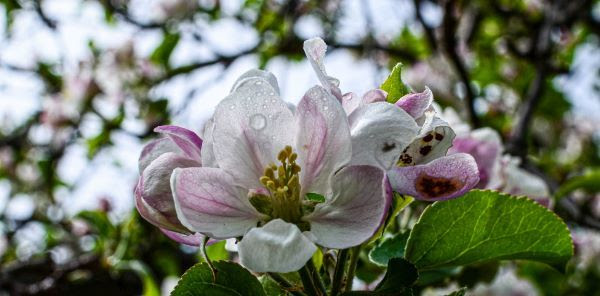 There’s no better way to celebrate Arbor Day than bringing home a tree to plant! Will it be a shade tree? One that makes fragrant flowers? A native tree? Or a tree that grows tasty fruit? Follow the steps to plant a tree the right way to ensure that it will flourish. Get more planting tips from the Arbor Day Foundation. There’s no better way to celebrate Arbor Day than bringing home a tree to plant! Will it be a shade tree? One that makes fragrant flowers? A native tree? Or a tree that grows tasty fruit? Follow the steps to plant a tree the right way to ensure that it will flourish. Get more planting tips from the Arbor Day Foundation.
- Choose the right tree for your location and climate. Don’t plant under a power line or over underground service lines – visit MissDig.org to get them marked.
- Dig a hole three times wider than the tree’s container and about as deep.
- Set the tree in the middle of the hole, and bring the root collar (the place where the roots meet the stem) just above ground level.
- Backfill the hole firmly with soil, creating a basin where water can settle.
- Water the tree and spread mulch around the base, leaving space around the trunk. Don’t build a mulch pile around the tree’s trunk, which can grow mold.
- Water frequently in the first year and watch your tree grow big and beautiful.
 Watch the video awards for the Michigan Arbor Day Alliance’s “Trees For our Health” fifth-grade poster contest, connecting students with nature through art. Winners received tree plantings for their schools. Watch the video awards for the Michigan Arbor Day Alliance’s “Trees For our Health” fifth-grade poster contest, connecting students with nature through art. Winners received tree plantings for their schools.
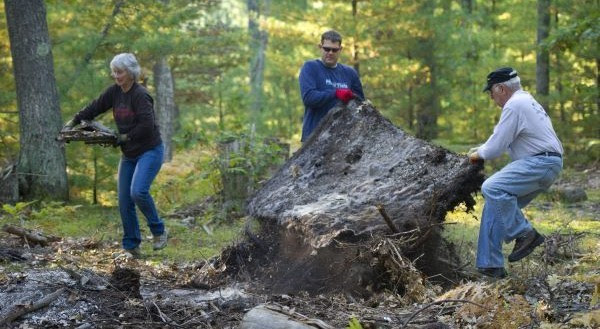 Melting snow in the forest has given way to springtime sprouts and wildflowers, but is also revealing unsightly trash and dump sites hidden during the winter season. Melting snow in the forest has given way to springtime sprouts and wildflowers, but is also revealing unsightly trash and dump sites hidden during the winter season.
Help care for the outdoor places you love by planning an Adopt-a-Forest cleanup, a perfect activity to recognize Earth Day, Arbor Day or any day that nature inspires.
The Michigan Adopt-a-Forest program, founded in 1991, celebrates its 30th anniversary this year. In 2020, volunteers completed an incredible 100 cleanups in 100 days, removing 459 cubic yards of trash from state forest lands. They plan to keep the momentum going and need new volunteers to join the effort.
Here’s how to lend a hand: Visit CleanForests.org to learn about safety and sign a volunteer waiver. Then, it’s time to get outside and complete a cleanup! Use our searchable dump site map to decide where to go. Sites are ranked by size, so it’s easy to find one appropriate for small, socially distanced groups.
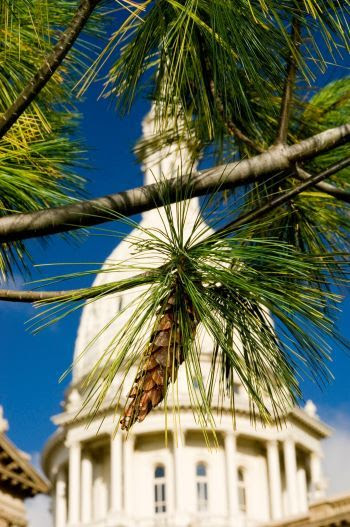 The beautiful, towering eastern white pine is a fitting pick for Michigan’s state tree. The beautiful, towering eastern white pine is a fitting pick for Michigan’s state tree.
The white pine can be identified by deep green needles that grow in clusters of five and swish in the breeze. White pines have gray bark and produce long cones. These trees grow fast and tall. How tall? More than 100 feet up in the wild!
The white pine was made Michigan’s official tree by Public Act 7 on March 4, 1955, commemorating the tree’s importance to our state’s history. At one point, Michigan was the leading timber producer in the nation due to its vast stands of this native tree.
Today, we still harvest trees, but now Michigan’s state forests are certified by two independent agencies as using responsible management practices to ensure that we’ll have trees for today and for future generations. |
 This year, the National Association of Conservation Districts celebrates Stewardship Week, April 25-May 2, with a special focus on trees that links up perfectly with Arbor Day. Events include virtual webinars and other resources on tree-related topics. This year, the National Association of Conservation Districts celebrates Stewardship Week, April 25-May 2, with a special focus on trees that links up perfectly with Arbor Day. Events include virtual webinars and other resources on tree-related topics.
Contact your local conservation district to learn more about how to help promote forest conservation in your community and how to get involved as a volunteer. |
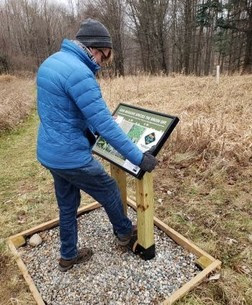 Have you seen a boot brush station at the trailhead of your favorite pathway? Have you seen a boot brush station at the trailhead of your favorite pathway?
These stations help people brush off any invasive plant seeds or bugs that might be hitchhiking on your boots from trail to trail. Using a boot brush can help protect the trails and forests you love from the devastating effects of invasive species that outcompete or devour native plants. Stand firm, give your boots a brisk scuffing to knock off any packed dirt and you’re ready to hike! Do the same thing at the end of your adventure to remove anything you may pick up on the trail.
Visit Michigan.gov/Invasives to learn about more actions you can take to prevent the spread of invasive species. |
|





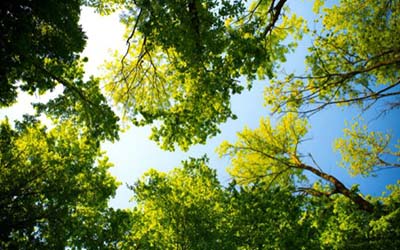

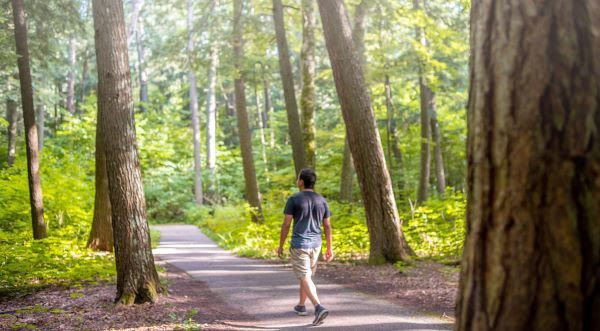
 Arbor Day, first held in 1872, was envisioned as a way to spread awareness about the importance of trees and to encourage tree planting.
Arbor Day, first held in 1872, was envisioned as a way to spread awareness about the importance of trees and to encourage tree planting. Get into the spirit of Arbor Day by
Get into the spirit of Arbor Day by There’s no better way to celebrate Arbor Day than bringing home a tree to plant! Will it be a shade tree? One that makes fragrant flowers? A native tree? Or a tree that grows tasty fruit? Follow the steps to plant a tree the right way to ensure that it will flourish. Get more
There’s no better way to celebrate Arbor Day than bringing home a tree to plant! Will it be a shade tree? One that makes fragrant flowers? A native tree? Or a tree that grows tasty fruit? Follow the steps to plant a tree the right way to ensure that it will flourish. Get more 
 Melting snow in the forest has given way to springtime sprouts and wildflowers, but is also revealing unsightly trash and dump sites hidden during the winter season.
Melting snow in the forest has given way to springtime sprouts and wildflowers, but is also revealing unsightly trash and dump sites hidden during the winter season. The beautiful, towering eastern white pine is a fitting pick for Michigan’s state tree.
The beautiful, towering eastern white pine is a fitting pick for Michigan’s state tree.
 This year, the National Association of Conservation Districts celebrates
This year, the National Association of Conservation Districts celebrates  Have you seen a boot brush station at the trailhead of your favorite pathway?
Have you seen a boot brush station at the trailhead of your favorite pathway?



